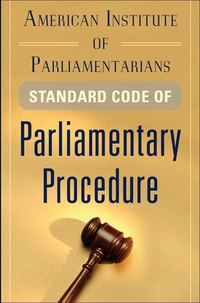Robert’s isn’t the only game in town – consider AIPSC
Guest post by Weldon L. Merritt, PRP, CPP

Although not as widely recognized as RONR, the American Institute of Parliamentarians Standard Code of Parliamentary Procedure (AIPSC) has been adopted by some organizations (most notably, many medical organizations) as their parliamentary authority. So how does AIPSC differ from RONR? The following table shows some of the more important (but by no means all) differences.
| RONR | AIPSC |
|---|---|
| 714 pages, including index, plus 50 pages of preliminary material and 52 “tinted pages” | 326 pages, including index, plus 10 pages of preliminary material |
| 32 named motions (including some that AIPSC classifies as “requests” rather than “motions”) | 19 named motions plus 5 named requests |
| Table (properly, Lay on the Table) legitimately may be used only to temporarily set something aside to deal with an urgent matter. Requires a majority vote without debate. | Table (properly so named) is used to kill a motion. Requires a two-thirds vote without debate. |
| Previous Question is used to close debate. Confusing terminology. | Close Debate is used to close debate. Straightforward and non-confusing terminology. |
| Limit or Extend Debate is itself undebatable. | Limit or Extend Debate is subject to limited debate (specifically, to type and time of limitations). |
| When filling a blank in a motion, suggestions are voted on one at a time. The first one to receive a majority fills the blank, and any remaining suggestions are ignored. | When filling a blank, all suggestions are voted on. The one receiving the highest vote, provided it is a majority, fills the blank. |
| Reconsider may be moved only by a member who voted on the prevailing side on the motion to be reconsidered. | Reconsider may be moved by any member, regardless of how (or whether) the member voted on the motion to be reconsidered. |
| Rescind or Amend Something Previously Adopted (treated as variations of the same motion) requires (a) a two-thirds vote, (b) a majority vote with previous notice, or (c) a majority of the entire membership. (Exception for Bylaws; see below.) | Rescind or Amend a Previous Action (treated as separate motions) requires the same vote as adoption of the original motion. (Exception for Bylaws; see below.) |
| A member may not speak against a motion he or she made, even if the motion has been amended adversely. (The member may, however, vote against the motion.) | A member is free to speak (and vote) either for or against a motion he or she made. |
| Only the assembly may order removal of a disorderly member from the meeting. | Either the chair or the assembly may order removal of a disorderly member. |
| Bylaws initially adopted by majority vote. Amendment, if not otherwise specified in the bylaws, requires notice and a two-thirds vote. | Bylaws initially adopted by majority vote. Amendment, if not otherwise specified in the bylaws, requires notice and a majority of the legal votes cast. |
| Illegal votes (i.e., unintelligible votes or votes cast for unidentifiable or ineligible candidates) cast by legal voters are counted as votes cast, but not credited to any candidate. | Illegal votes are ignored in computing the number of votes cast. |
| No Frequently Asked Questions included in the book. (The RONR web site does include a FAQs list at robertsrules.com/frequently-asked-questions.) | Frequently Asked Questions chapter included. |
| Includes one appendix containing Sample Rules for Electronic Meetings. | Includes nine appendices containing various forms and useful information. |
| Definitions of parliamentary terms embedded within the text. | Separate list of definitions of parliamentary terms. |
AIPSC is a successor to an earlier work published by Alice Sturgis in 1950 and titled, The Standard Code of Parliamentary Procedure (TSC, also often referred to as “Sturgis”). That work “challenged the notion that deliberative meetings should be conducted only by procedures established in the nineteenth century. It declared that rules should be simplified as much as possible and should be explained in understandable language.” TSC (4th ed.), p. xxiii.
By 2001, TSC had gone through four editions, with the fourth edition having been revised by the American Institute of Parliamentarians (AIP). In 2009, the AIP Board of Directors voted to proceed with steps toward publication of a fifth edition. Due to copyright issues, however, AIP instead embarked on production of a completely new work based on the principles of TSC, but with a new title. The result was the publication, in 2012, of AIPSC.
AIPSC continues the legacy of Alice Sturgis, as first codified in TSC, but with several new features. The result is “a useful reference that is consistent with modern meeting needs and practices.” AIPSC, p. viii. As such, it continues to be “a challenge to Robert’s Rules of Order.” TSC (4th ed.), p. xxiii.
So should your organization adopt AIPSC as its parliamentary authority? Each organization must decide that question for itself. The important thing to know is that there is an alternative to RONR. (There are, in fact, several other parliamentary authorities that could be used in lieu of RONR. But discussion of all of the available alternatives is beyond the scope of this article.) If your organization does decide to adopt AIPSC, the recommended language from AIPSC, p. x, is:
The American Institute of Parliamentarians Standard Code of Parliamentary Procedure shall govern the Association in all cases to which it is applicable and is not inconsistent with the bylaws and standing rules of the Association.
Another appropriate term may, of course, be substituted for “the Association,” if that term is not suitable for your organization.
Even if your organization chooses to stick with RONR as its parliamentary authority, you may find AIPSC to be a useful source of ideas for Special Rules of Order that could be adopted to replace one or more RONR rules that your organization finds unsuitable.

Ⓒ Weldon L. Merritt 2020. All rights reserved.


Thank you for this informative and interesting post! From time to time we get requests for alternative meeting procedures frameworks. I will keep this close at hand!
Vince, so glad to know that you find it helpful! Thanks for writing.